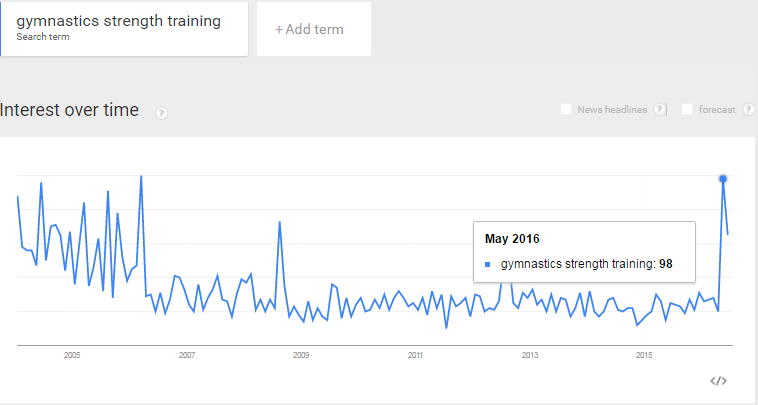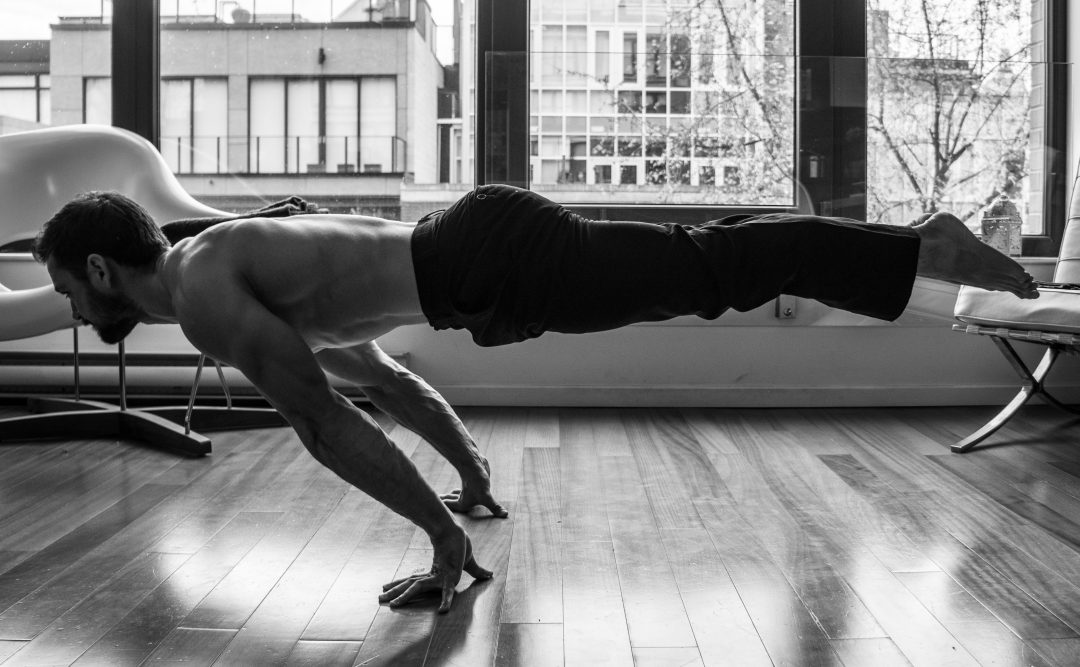The Gymnastics Strength Training method has recently gained more exposure through social media and has experienced a spike in popularity. Whether this spate of attention is long-lasting or simply a passing phase remains to be seen.
This post will give you a high level introduction about what it is, and some of the benefits we can experience when training this way.
Why is Gymnastics Strength Training getting more attention?
While there may be many other factors involved in the newfound interest for gymnastics, I believe it was Tim Ferriss’ The Secrets of Gymnastic Strength Training podcast with US national team gymnastics coach Christopher Sommer which raised curiosity levels.
Released in early May this year – I believe it’s a worthwhile listen, especially for beginners.
A quick look at the Google Trends graph for Gymnastics Strength Training adds more credibility to my prediction.

The Tim Ferriss Effect
Before I delve into the short list of benefits, let’s first understand a bit more about Gymnastics Strength Training.
What is Gymnastics Strength Training?
In short, I would define Gymnastics Strength Training as a means of building up a your baseline level of strength primarily though gymnastics and bodyweight-based exercises. This strength can then be applied in several ways:
Advancing into training for more difficult progressions of fundamental gymnastic movements, such as those on the floor, rings or bar.
Advancing into weighted variations of basic pushing or pulling exercises typically performed with bodyweight, such as weighted chinups, pullups, muscle ups, or dips.
Transitioning into a conventional strength training protocol, such as those used for Powerlifting, Olympic Weightlifting or to a degree; Bodybuilding.
All the above. An impressive balance between an ability to manipulate your bodyweight, perform weighted bodyweight exercises, and achieve respectable numbers when performing heavy compound movements with a barbell.
Gymnastics Strength Training is not easy. Progression is often slow, which for someone who wants to experience amazing results with minimum work, will only serve as a source of frustration.
But, like with most things that take considerable time and effort, the rewards will pay dividends if you simply stick with it.
Listed below are five reasons why you could consider Gymnastics Strength Training.
1) Anytime, anywhere.
The majority of my training has been centered around Gymnastics Strength Training and Calisthenics since I began in January 2012.
My motivating driver at the time involved wanting to make a physical change without having to tentatively commit to a gym membership. I also preferred the convenience of training at home, especially when I was a final year post-grad student and wanted to cut down on unnecessary travel to the gym.
The beauty of this style of training involves the lack of equipment you need to begin and get started. If building up ring strength is your goal, you can simply buy a pair of rings online and take them to a nearby park and work from there.
If working towards the planche is the journey you’re embarking upon, floorspace or a pair of paralletes will satisfy many of your requirements.
No machines, no heavy weights, just you and your fight against gravity.
2) Many ways to improve and get stronger.
The moves we see high level gymnasts perform is the culmination of many years of hard work, and progression through many regressions (easier variations) of the movements you see before you.
As an example, anybody can do a bench press, whether it’s simply with a wooden stick or a substantial amount of weight.
The movement pattern remains unchanged.
On the other hand, ask somebody new to attempt an iron cross on the rings and you’ll see this is an impossible task. The end goal can only be reached through a series of regressions of this movement while the strength base is slowly built up.
And how is this done?
By taking simple movements and making them more and more difficult over time.
Unlike the linear way of training with dumbbells (more weight!), there are many variables that can be changed with Gymnastics Strength Training.
For example, we can change-up tempo (with eccentrics), hold times (with isometric exercises) or height (in the case of rings).
Coupled together, these variables ensure a hypertropic response is felt, meaning that muscle growth and strength gain will be inevitable. In saying this, I’m assuming that you’re not shooting yourself in the foot with poor sleeping habits and a questionable diet.

Steve Atlas (@steve_atlas)
Regardless of training style, the way we look after ourselves does not change.
Changing the way we do a simple exercise, even slightly, can have a profound impact on its difficulty, and your strength build up over time.
3) Development of straight arm strength.
Straight arm strength, what’s that?
Exactly. There’s painfully little, if any, emphasis placed on the development of straight arm strength for the average person following a cookie cutter bodybuilding program.
In a nutshell, Christopher Sommer defines straight arm strength work in the following way:
Straight arm strength refers to moving the body without the advantage of bending the joints. Essentially then, by increasing the length of the lever, we greatly magnify the intensity of the exercise.
We have a tendency to spend a lot of time in muscle flexion, meaning that we decrease the angle of our joints during an exercise. To keep things simple, assume that the joint in question is our elbow.
The angle reduction makes sense, because it’s easier, we feel stronger, and it’s “safer”. As an example, think about how much easier it is to do a pullup when starting from half way, instead of from a dead hang.
Alternatively, think of a bicep curl, and how it gets progressively easier as you bring the weight up.
In Gymnastics Strength Training, regressions of the planche (pictured below) is a common starting point for beginners when starting out with straight arm work. This is an example of muscle extension, meaning that by increasing the angle of our joints, we make the exercise more difficult.
This movement also has a nice carryover to front deltoid, shoulder and bicep development(!)

4) Transferability to conventional strength training.
The benefit of straight arm strength work is that it builds up an impressive strength base which carries over to deadlifts and weighted pulling movements.
One of my student’s, JJ Gregory, far exceeded my own modest accomplishments. On his first day of high school weight lifting, JJ pulled a nearly triple bodyweight deadlift with 400 pounds at a bodyweight of 135 and about 5’3″ in height. On another day, he also did an easy weighted chin with 75 pounds, and certainly looked as though he could’ve done quite a bit more. – Christopher Sommer
In October 2013, after never incorporating deadlifts into my training, I was able to max out at 200kg/441lbs.
My form was not textbook by any means, but I use this as an example of how my bodyweight training was able to carry over to a loaded bar.
One of the reasons why this strength comes about is due to the amount of time under tension straight arm work places on our tendons and ligaments.
It’s extremely easy to be captivated by big muscles, but what about the middle man – our connective tissues? If these are not strengthened over time, it’s not a matter of if and injury will occur, but when.
You’ll often be surprised at the incidental strength gain that’s possible when you become increasingly more adept at performing bodyweight exercises well.
5) Build a proportionate physique.
Lastly, a training regimen that consists of primarily bodyweight movements is able to generate a considerate amount of muscle. This assumes, of course, that you are training hard, intelligently and not simply going through the motions.
The idea of training a specific body part in Gymnastics Strength Training is absurd, where in a simple sense, most training sessions could be viewed as a complete “upper body workout”. However, you need to pay attention to the following:
The responsibility of training your legs rests solely on you.
Gymnastics Strength Training does not traditionally place a strong emphasis on conventional lower body training, which can hinder development in this area if you neglect it.
If your aim is to specialize with your Gymnastics training and reach your goals sooner, I can see the merit in not approaching your lower body training with the same level of dedication. However, if your goal is aesthetic and/or practical progression, it’s best advised to not “skip leg day” and dedicate at least one day a week to training your lower body.
What are you waiting for?
I believe Gymnastics Strength Training would prove beneficial for anybody, whether you’re a complete beginner or someone with substantial lifting experience.
It’s also incredibly humbling, because I’ve observed that proficiency with the barbell does not always guarantee competence with bodyweight exercises.
Using rings for the first time, in particular, can prove to be quite a grounding experience.
My recommendation is to give it a shot for at least 6 weeks. If it’s not your cup of tea, then at least you’ve learned a bit more about this style of training.
Either way, I’d be interested in hearing about your experiences.
Good luck.

